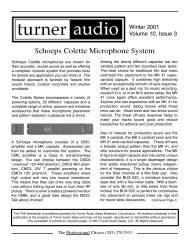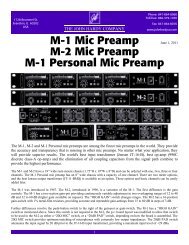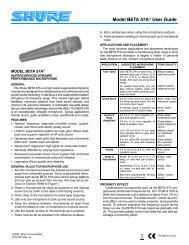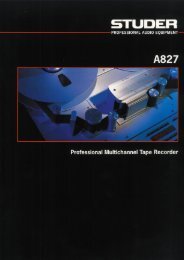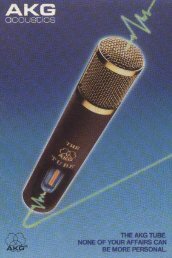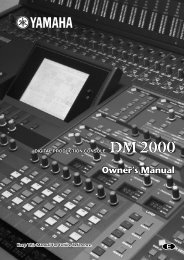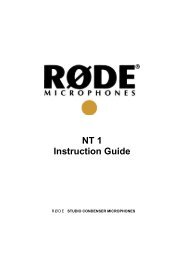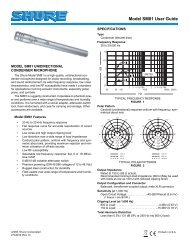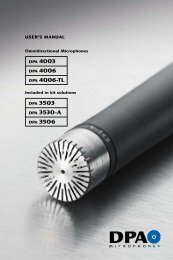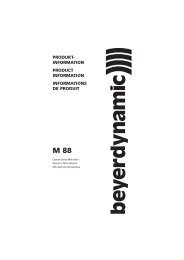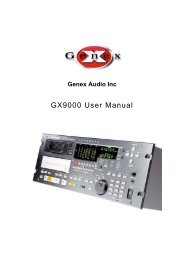Lexicon 480L | PDF - Freeverb3
Lexicon 480L | PDF - Freeverb3
Lexicon 480L | PDF - Freeverb3
You also want an ePaper? Increase the reach of your titles
YUMPU automatically turns print PDFs into web optimized ePapers that Google loves.
Bank 7: the Sampler Programs<br />
Optimizing Level Triggered Playback<br />
These tips will enable you to obtain tight level triggering<br />
for percussion replacement and other critical applications.<br />
14. Make sure there is no "dead air" at the head of your<br />
sample. The non-percussion samplers are preset to<br />
MARK and preserve a few milliseconds of pre-trigger<br />
audio for the FAST FADE UP. You may either MARK<br />
THE HEAD (0 milliseonds) or trim this later.<br />
15. Marking the HEAD while using the preset -24dB<br />
level-triggered recording should provide a tight enough<br />
HEAD trim for most users. You may tighten the recording<br />
further by setting MODE to a higher dB level.<br />
16. Besure to set FADE TYPE to PERCUSSION for<br />
sounds with tight, clean attacks. If the cue is still too<br />
loose, then trim HEAD until just before you hear loss of<br />
the attack.<br />
17. Adjust TLV, playback trigger level, for the greatest<br />
sensitivity that doesn't give false triggers.<br />
Note: If you are using level retriggering to interrupt<br />
and restart sample playback, a combination of too<br />
sensitive a trigger level and insufficient retrigger<br />
holdoff time can lead to a stuttering, which some<br />
hear as a great effect. If it's not for you, remember<br />
these general guidelines.<br />
• Use a short duration retrigger signal with a sharp<br />
attack.<br />
• Raise the level threshold - if this can be done<br />
without delaying the initial trigger.<br />
• Make the HOLDOFF time as long as possible<br />
The Bank 7 Dual Rate Change sampler has a fixed<br />
retrigger HOLDOFF of about 100 milliseconds. The<br />
forward/reverse sampler cannot perform level retriggering,<br />
it can only be retriggered manually or via MIDI.<br />
Using Rate Change Samplers<br />
1. Both SME samplers and the Bank 7 sampler, Dual<br />
Rate Change, permit you to adjust the playback RATE.<br />
Starting with Version 3.00 software, the display now<br />
shows percent of normal speed and, over a certain<br />
range, musical interval from unison. The pitch interval<br />
display corresponds to that of the pitch changer, Bank<br />
8, programs 1 through 6, and shows the range over<br />
which you may correct the sampler's pitch. You can<br />
cascade these programs for simple time compression.<br />
2. The non-SME Dual Rate Change sampler allows<br />
you to record, edit and playback two independent<br />
samples. Use the VX, RECORD VOICE slider to select<br />
a voice for the Page 1 Record controls. Record and<br />
check a sample as above.<br />
3. There are two independent editing pages, and<br />
independent play controls for each voice. Voice 1<br />
comes out the left side, Voice 2 out the right.<br />
Using the non-SME FORWARD/REVERSE<br />
Samplers<br />
1. The sampler is preset to play only the forward<br />
voice. To activate the reverse voice, adjust REV TIME<br />
(slider 5) to some large number, and adjust TAIL TRIM<br />
to tighten the beginning of the backwards play.<br />
2. To turn off either voice, move its TIME slider to<br />
0.000 SEC.<br />
3. To adjust the relative start times of two active<br />
voices, use the "" slider, PLAY ORDER. For a<br />
different kind of inverse effect, try sliding the forward<br />
voice so that it starts just as the reverse is finishing.<br />
4. Adjust the relative gains and panning of each<br />
voice on Page 3.<br />
6-5


